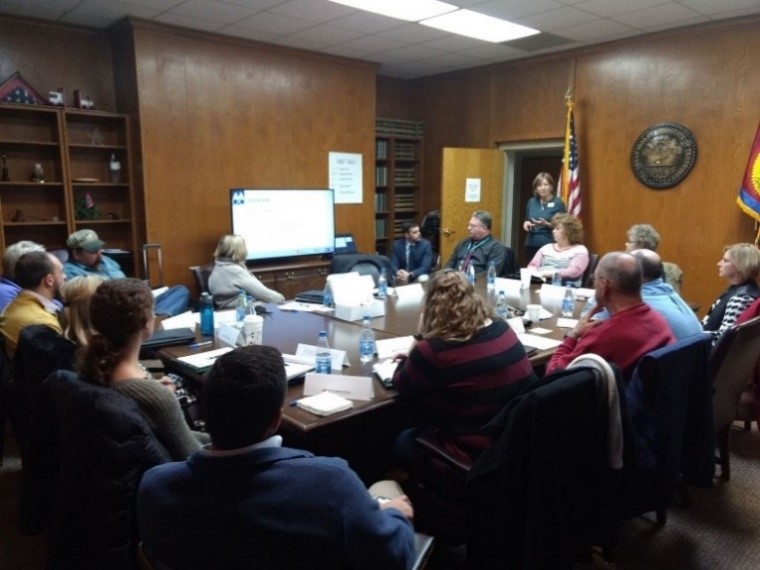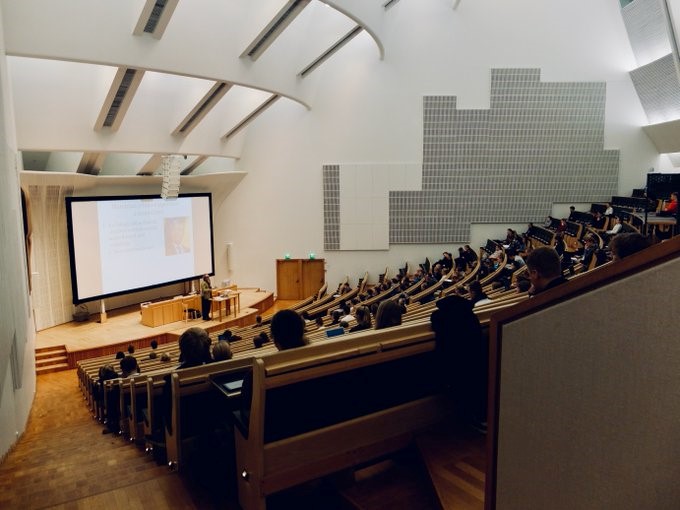
April 2021
In This Issue
Spotlight: University of Oregon’s University Center Uses Solar Eclipse to Springboard Planning for Economic Resiliency in the Beaver State The August 2017 eclipse is seen in this NASA photo taken in Madras, Oregon. On August 21, 2017, millions of Americans bore witness to a once-in-a-lifetime event: the first solar eclipse viewable across the entire mainland United States in nearly a century. Oregon, where the eclipse was first seen, realized an unprecedented surge of visitors as hundreds of thousands of people flocked to the Beaver State for days. In Eugene, the University of Oregon’s University Center took a leading role in evaluating the state’s response to the eclipse and identifying key learnings that will help Oregon plan for the next big event. The University of Oregon’s Economic Development Administration University Center (EDAUC) links the resources of the University of Oregon with communities across the state to enhance sustainable economic development. It began laying the groundwork for research into the public and private sector response to the eclipse in the spring of 2017 by developing two surveys. A pre-event survey was administered to economic planners prior to the eclipse, and a post-event survey was deployed the following January. The two surveys were augmented by interviews that provided a qualitative dimension to quantitative data. The process concluded with a series of tabletop exercises enlisting critical stakeholders across the state. Success Story: The University of Tennessee Helps Rural Communities Realize Untapped Assets Brainstorming assets and opportunities in Carter County, Tennessee The University of Tennessee University Center (UTUC) has created an innovative planning process to assist local communities in realizing their economic potential. The UT Asset-Based Planning Program is specifically designed to identify all available assets and opportunities in order to best promote economic development. Through the Asset-Based Planning Program, UTUC is partnering with two economic development organizations through this initiative – both the Tennessee Development Districts Association (TDDA) and Tennessee Economic and Community Development (TNECD) are committed to revitalizing local communities through economic development and quality-of-life services. This partnership initiative began in 2016 with 44 at-risk counties, and today services 79 counties across the state. UTUC has conducted 142 planning sessions with a variety of community stakeholders, which have identified key community interests. In response, TNECD has awarded 105 competitive grants totaling more than $4.6 million to support these economic development plans. They have also incorporated this initiative into Tennessee’s ThreeStar Program, promoting economic and community prosperity across the state. Highlight: EDA Supports the University of Albany’s Work in Cybersecurity to Help Protect Businesses in the New York Region University of Albany Digital Forensics and Cybersecurity FACETS CENTER
EDA partnered with the University of Albany’s Forensics, Analytics, Complexity, Energy and Transportation Security (FACETS) Center through our University Center program in 2011 to foster cybersecurity innovation, public-private partnerships, and cyber job growth in the New York Capital District. This University Center is building an engine of economic growth through collaborations, research, entrepreneurial opportunities, and jobs in the field of cybersecurity. The University’s Cyber Innovation Laboratory allows academic researchers and businesses to test their cyber defenses against different attacks such as malware, intrusion, and denial-of-service. The Lab supports research, industry innovation, and training via data collection servers and its own self-contained quarantined network to prevent malware from escaping into the global network. Recently, researchers at The Lab collaborated with General Electric to understand behavioral triggers for identification of potential malicious insiders within an organization. In their approach, the team designed probes to trigger malicious users into action that can be detected. They created simulated conditions to reflect common insider motivations by asking subjects to roleplay an insider and test how they would respond to different scenarios and react to different probes. |
|
|
|||
EDA’s Updated Investment Priorities This month, EDA published its updated Investment Priorities. EDA’s investment priorities provide an overarching framework to ensure its grant investment portfolio – ranging from planning to infrastructure construction -- contributes to local efforts to build, improve, or better leverage economic assets that allow businesses to succeed and regional economies to prosper and become more resilient. Equity has been added to the top of EDA’s investment priorities list.  EDA Launches 2021 University Center NOFOEDA has launched its 2021 University Center Competition for higher education institutions in states/territories within EDA’s Chicago and Philadelphia regions. To access both funding opportunities, visit: https://www.eda.gov/funding-opportunities/#fy21-university-centers. EDA Seeks Applications for Targeted Pre-Development Technical Assistance to Distressed Small, Rural, and Underserved CommunitiesEDA is interested in receiving applications for one or more National Technical Assistance (NTA) cooperative agreement(s) to provide guidance and direct technical assistance to distressed small, rural, and underserved communities in pre-development activities associated with accessing EDA programs and services. For more information, check out our new Targeted Pre-Development Technical Assistance page here. EDA Publishes FY2021 –2023 EDA Planning and Local Technical Assistance ProgramThrough its Planning and Local Technical Assistance programs, EDA assists eligible recipients in developing economic development plans and studies designed to build capacity and guide an area or region's economic prosperity and resiliency. The Planning program helps support organizations, including District Organizations, Indian Tribes, and other eligible recipients, with Short Term and State Planning investments designed to guide the eventual creation and retention of high-quality jobs, particularly for the unemployed and underemployed in the Nation’s most economically distressed regions. Learn more by visiting EDA’s Funding Opportunities page.
EDA in the News!EDA receives $4M in funds to help Texas workforce recover from pandemic US EDA unveils updated investment priorities Commerce Awards $29M in Coronavirus-Related Innovation Grants U.S. Department of Commerce Awards $29 million in SPRINT Challenge grants to respond to coronavirus pandemic SouthernTech awarded $4 million for Aviation Maintenance Training City of San Jose receives $1.17 million federal grant for business recovery, jobs |

